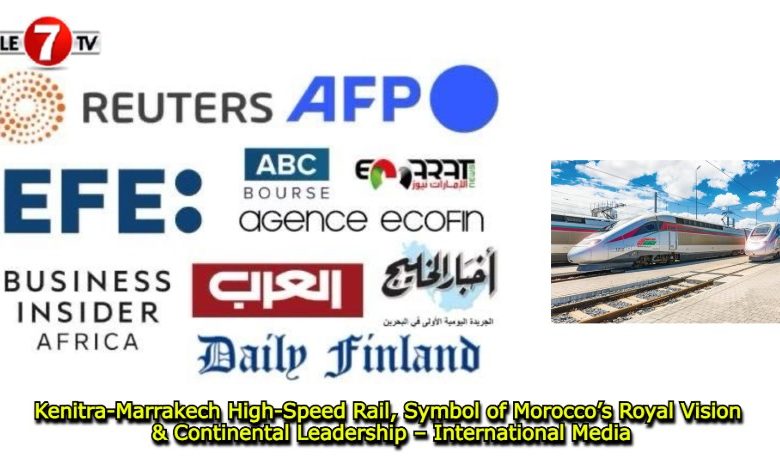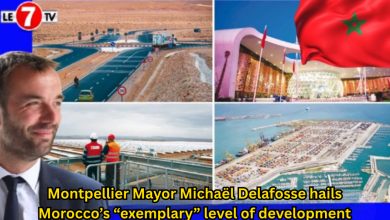Kenitra-Marrakech High-Speed Rail, Symbol of Morocco’s Royal Vision & Continental Leadership – International Media

The launch of the Kenitra-Marrakech High-Speed Rail (HSR) project by HM King Mohammed VI has drawn broad coverage from the international press, which hailed it as a reflection of the Sovereign’s “enlightened vision” and Morocco’s growing stature as a “continental leader” in infrastructure development.
Business Insider Africa wrote that the project consolidates Morocco’s position as a “continental leader in infrastructure development”, recalling that the kingdom is already home to Africa’s only operational HSR system — the Al Boraq line between Tangier and Kenitra.
Through this project, “Morocco is doubling down on its rail ambitions with this new phase, setting itself apart as a case study in sustainable transport and regional integration”, the English-speaking outlet underlined.
More than a transportation upgrade — it’s a “strategic lever for national competitiveness”, as Morocco is leveraging its rail expansion to develop a homegrown industrial ecosystem with significant local content, Business Insider Africa noted.
Daily Finland wrote that this large-scale project reflects the Sovereign’s “enlightened Vision” of improving the national rail service, and is in line with the Kingdom’s strategic orientations, under the impetus of HM the King, in terms of sustainable development, particularly promoting low carbon footprint collective mobility solutions.
It also illustrates Morocco’s “firm determination” to carry on the development of the national rail network, so that it can fully play its role as the backbone of a sustainable and inclusive transport system, the daily said.
ECOFIN Agency underscored Morocco’s firm leadership on the continent, writing that the extension consolidates its position as the only African country with an operational high-speed rail network. The line forms part of a broader push for sustainable mobility and structured economic development, the outlet added.
Beyond national ambitions, the project is seen as a technological showcase for other African nations seeking fast and eco-friendly transport solutions.
Specialist site ABC Bourse emphasized that Morocco continues to cement its unique status on the continent by expanding the Al Boraq network. The publication linked the new line to commitments made during French President Emmanuel Macron’s state visit to Morocco in October 2024, during which several rail-related agreements were signed.
It added that this French-Moroccan partnership illustrates a shared strategic vision around sustainable infrastructure, green mobility, and co-industrialization.
Reuters reported that the HST project aligns with Morocco’s broader modernization drive and preparations for the 2030 FIFA World Cup, to be co-hosted with Spain and Portugal. Designed for a speed of 350 kilometers per hour, the line will cut the journey between Marrakech and Tangier by two hours, to 2 hours and 40 minutes, while travel time between Rabat and Casablanca’s main airport will be reduced to 35 minutes, the agency pointed out.
Agence France-Presse (AFP) noted that Alstom had secured the contract to supply 18 high-speed trains for the line. AFP recalled that the project had been discussed during President Macron’s October visit to Rabat, quoting French Minister Delegate for Foreign Trade Laurent Saint-Martin as saying the contract marked “a new and complementary phase in the transfer of expertise between France and Morocco.”
In the run-up to the 2030 World Cup, Morocco is accelerating infrastructure investments across key sectors including transport, hospitality, telecommunications, and airports, AFP added.
The Spanish news agency EFE, for its part, reported that the new high-speed line will cut travel time between Kenitra and Marrakech in half, covering a distance of 430 kilometers.
The line will also link the international airports of Rabat and Casablanca, EFE added, noting that this major infrastructure project will require an investment of 53 billion dirhams (excluding rolling stock) and forms part of a broader national program totaling 96 billion dirhams.
Arab media outlets also hailed the HST project as a major milestone in Morocco’s infrastructure development. The London-based newspaper Al Arab described the HST as a “qualitative leap” in Morocco’s transportation system, supporting the Kingdom’s ongoing socio-economic transformation.
According to the publication, the project is part of a broader portfolio of initiatives launched under the Sovereign’s vision for inclusive and sustainable development across multiple sectors.
The launch of this flagship project, the newspaper added, comes as Morocco enters a new phase of modernization and performance improvement within the transport sector. It aims to ensure better integration into the country’s economic momentum while reinforcing social progress and facilitating individual mobility.
The article further noted that the new high-speed line is expected to revitalize commerce and business activity, generate employment, and offer a reliable alternative to road transport.
Meanwhile, Bahraini daily Akhbar Al Khaleej emphasized Morocco’s strong commitment to expanding and modernizing its rail infrastructure, positioning it as the backbone of a sustainable and inclusive transport system.
The newspaper reported that the national railway network is undergoing a significant transformation, including not only the extension of the high-speed rail to Marrakech, but also the renewal of ONCF’s rolling stock and the establishment of a modern public transport system and emerging industrial ecosystem.
Highlighting the economic and industrial impact, the outlet cited Morocco’s unprecedented program to acquire 168 new trains, which will enable the growth of a domestic railway industry with a local integration rate surpassing 40%.
In turn, Emirati news site Emarat News underscored that the project reflects an ambitious Royal vision to reinforce Morocco’s status as a regional hub for smart and sustainable mobility.
The project, it added, is part of a wider strategy to connect the north and south of the Kingdom, strengthening Morocco’s role as a strategic link between Europe and Africa via a forward-looking continental rail network.
The publication also stressed that the initiative fits into a global effort to expand Morocco’s low-carbon rail offering by connecting major cities through a modern transport system aligned with urban expansion and sustainable economic growth. The new high-speed line, it concluded, delivers significant gains in travel efficiency and industrial development.
La rédaction/Le7tv





